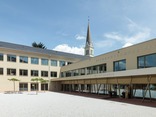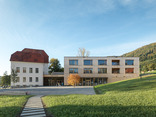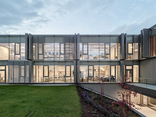Bauwerk
School of Economics
Rok Benda, Primož Hočevar, Mitja Zorc - Murka Sobota (SLO) - 2007

School of Economics, Murska Sobota
Rok Benda, Primož Hocevar and Mitja Zorc designed a building that deserves to become a point of reference in Slovenian contemporary architecture.
31. Juli 2008 - Petra Ceferin
After admiring a building in photographs, I’m always a bit afraid I’ll be disappointed when I actually get to see it on site. When I am not, I feel almost gratified. And it is even more satisfying when its users, whom I sometimes meet by chance, tell me that they really enjoy the place. For me this acts as a confirmation that even today, architecture can do more than just excite the architects, fulfil some useful functions or help developers and investors sell their real estate for yet higher prices.
This is what happened during my visit to the School of Economics in Murska Sobota, the easternmost and economically least developed town and region in Slovenia. I was supposed to be guided through the building by the school’s management but as chance would have it, I was introduced to it by a cook, who was taking a break beside the service entrance. She was very pleased to hear that I was interested in seeing the interior and told me proudly, with a strong local accent, that she worked there. She offered to let me in: so I first saw the kitchen and only after that visited the rooms and halls that were meant to be seen by visitors like myself. She and other staff told me that the building was brand new, that they had just started to work there and that it was really great. For them this building was the beginning of something new and promising.
Indeed, the building can be considered a beginning in several ways. Not only because it has just opened its doors but because it offers a new opportunity for many students, teachers and other employees to develop their careers, because it is one of the first recently-realized buildings in a new part of town that is still under construction and because it is part of a new and wider development of the region. It is also a new beginning for Rok Benda, Primož Hoevar and Mitja Zorc, the architects who designed it. This is their first major realization. They received the commission as a result of an architectural competition held in 2002; five years later the building was completed, and just a month ago it earned them the country’s most prestigious architectural prize – the Jože Plecnik award.
This low, compact building houses a complex programme for a Secondary School of Economics, structured in three parts that correspond to the three sections of the building. In the front section we find the main hall, lecture hall and library, the central section houses a cafeteria and the entrance, lecture hall and administration, and the end section contains a gymnasium. These sections stretch and bend along a long, narrow site in such a way as to generate several outdoor spaces. The building opens up to these spaces – parks, gardens and fields – through large glass walls. Particularly now, in middle to late spring, the views are amazing, astonishingly green. As a result, the building appears to be wrapped in a thick, bright green coat such that the cladding material – dark grey ceramic tiles – appears particularly fitting. The choice of material is doubly apt in that the region around Murska Sobota is very rich in clay and is well-known for its long tradition in ceramics and pottery. Perhaps the building’s success can be summarized as its ability to encapsulate various positive qualities of its environment; or, more precisely, to make the best of this environment visible.
Kenneth Frampton once explained that the task of an architectural critic is to highlight certain works and thus help establish them as points of reference in a more general discourse about what architecture is and what it might be in the future. The School of Economics in the remote town of Murska Sobota certainly deserves to become a special point of reference for Slovenian architecture.
This is what happened during my visit to the School of Economics in Murska Sobota, the easternmost and economically least developed town and region in Slovenia. I was supposed to be guided through the building by the school’s management but as chance would have it, I was introduced to it by a cook, who was taking a break beside the service entrance. She was very pleased to hear that I was interested in seeing the interior and told me proudly, with a strong local accent, that she worked there. She offered to let me in: so I first saw the kitchen and only after that visited the rooms and halls that were meant to be seen by visitors like myself. She and other staff told me that the building was brand new, that they had just started to work there and that it was really great. For them this building was the beginning of something new and promising.
Indeed, the building can be considered a beginning in several ways. Not only because it has just opened its doors but because it offers a new opportunity for many students, teachers and other employees to develop their careers, because it is one of the first recently-realized buildings in a new part of town that is still under construction and because it is part of a new and wider development of the region. It is also a new beginning for Rok Benda, Primož Hoevar and Mitja Zorc, the architects who designed it. This is their first major realization. They received the commission as a result of an architectural competition held in 2002; five years later the building was completed, and just a month ago it earned them the country’s most prestigious architectural prize – the Jože Plecnik award.
This low, compact building houses a complex programme for a Secondary School of Economics, structured in three parts that correspond to the three sections of the building. In the front section we find the main hall, lecture hall and library, the central section houses a cafeteria and the entrance, lecture hall and administration, and the end section contains a gymnasium. These sections stretch and bend along a long, narrow site in such a way as to generate several outdoor spaces. The building opens up to these spaces – parks, gardens and fields – through large glass walls. Particularly now, in middle to late spring, the views are amazing, astonishingly green. As a result, the building appears to be wrapped in a thick, bright green coat such that the cladding material – dark grey ceramic tiles – appears particularly fitting. The choice of material is doubly apt in that the region around Murska Sobota is very rich in clay and is well-known for its long tradition in ceramics and pottery. Perhaps the building’s success can be summarized as its ability to encapsulate various positive qualities of its environment; or, more precisely, to make the best of this environment visible.
Kenneth Frampton once explained that the task of an architectural critic is to highlight certain works and thus help establish them as points of reference in a more general discourse about what architecture is and what it might be in the future. The School of Economics in the remote town of Murska Sobota certainly deserves to become a special point of reference for Slovenian architecture.
Für den Beitrag verantwortlich: A10
Ansprechpartner:in für diese Seite: Hans Ibelings










